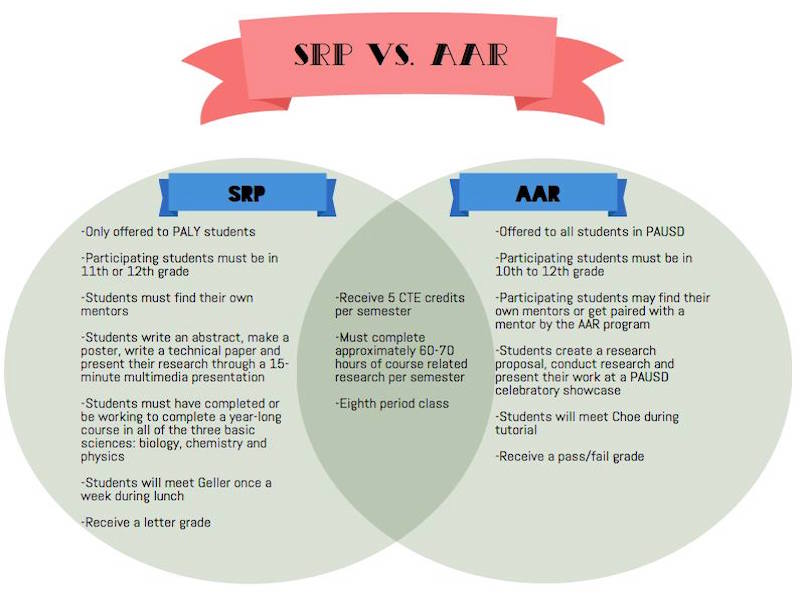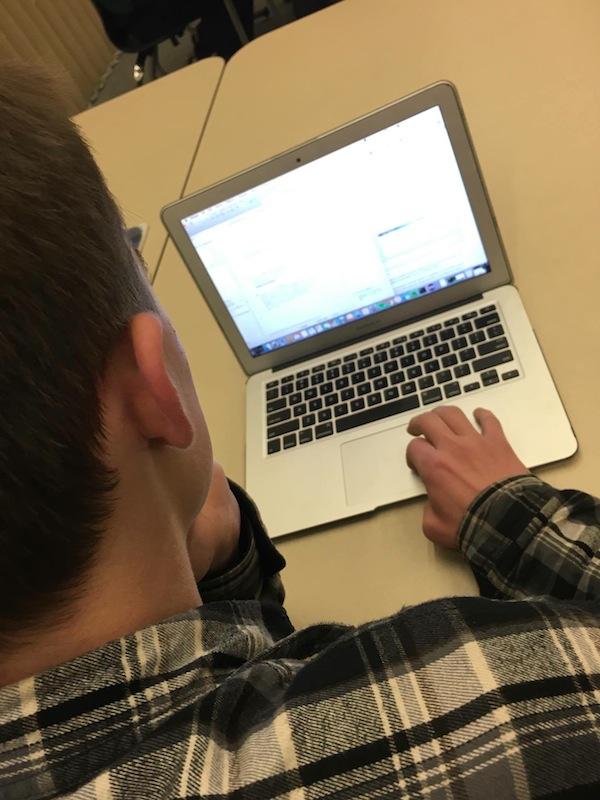Palo Alto High School is offering two research courses next year, Advanced Authentic Research — currently in its pilot year — and long-running Science Research Project.
Both AAR and SRP are programs that hope to ignite student passion by having students conduct real-world research with mentors working in a variety of fields. While the two courses may seem to be identical project-based classes, they have a few key differences that students should take note of when signing up for courses for next year, many of which are shown in the Venn Diagram below.

The main difference lies in what type of research projects participating students can pursue.
Junior Timothy Liu, an AAR participant whose project is a business idea targeted at students, says that while SRP students are limited to researching STEM topics, AAR students are connected with mentors in a variety of fields.
“With AAR, you get a lot more variety in terms of projects and mentors,” Liu said. “For instance, my project is on business, something that I’m much more interested in than science.”
Although SRP students must find their own mentors, Liu is one of many students in AAR who was connected to a mentor.
“Although I had the option of finding my own mentor, I didn’t previously have that many connections in the business world so getting assigned one was definitely helpful,” Liu said.
While having a mentor found for you is an upside that many students from both AAR and SRP stand by, some believe that having to find your own mentor can be beneficial.
“Drafting my email and interviewing [with labs] was really valuable, and I think that’s a really good skill that SRP teaches students,” senior and SRP Participant Gabi Rossner, whose research is about speech processing in natural conversations, said.
Both AAR and SRP will be offered as 8th period classes next year. AAR students will meet with Dr. Jeong Choe during tutorial, and SRP students will attend class meetings once a week at lunch with Keith Geller, the physics teacher in charge of SRP.
Rossner explains that having SRP meetings during Lunch helped her because she didn’t have enough room in her schedule to take SRP.
“I never had time in my schedule junior or senior year to take any extra science classes, so SRP being an 8th-period class is great because otherwise, I wouldn’t have been able to take another science class,” Rossner said.
Although similar, each course teaches students different skills and expects them to complete different assignments.
For SRP, students must write an abstract about their research in January, submit a poster on their research in February, and write a technical scientific paper as well as present a 15-minute multimedia presentation on their research in May.
AAR on the other hand requires students to write a research proposal in October, collect data through the end of March and present their work at a PAUSD celebratory showcase in May.
The two programs also differ in the way students are expected to conduct research.

SRP students often get a feel for what it’s like to work in a research lab, write a research paper and help with their mentor’s pre-existing research, while most AAR students come up with their own thesis and conduct their research independently from their mentors.
Junior Gaby Pelayo, an SRP participant whose research is focused on using drugs to improve muscle regeneration, explains that she helps her mentor with a specific research project that she has been working on for a long time.
“I didn’t create my own research proposal, but my mentor explained her research thesis to me, and I go to the lab a few days after school to conduct experiments on my own to further that research,” Pelayo said.
Contrastingly, AAR participant junior Ahana Ganguly, who is researching how Paly students define success, explains that she and her research partners conduct most of the research on their own.
“[My research partners and I] schedule appointments with [our mentor] when we think it’s necessary,” Ganguly said. “We go to him for advice and he helps edit our work, but we’re really the ones driving the project.”
Despite the courses’ similarities, Choe and Geller are unsure about whether or not the two courses will be ever be combined.
According to Choe, the prospect of the two programs merging has been considered, but it is still unsure if it will ever happen.
“I have been discussing [the possibility of merging the two courses] with Mr. Geller,” Choe said. “We want to first see what the sign-ups for both of the courses look like and then figure out what our next step is.”
According to Rossner, participating in SRP has been a great experience and has given her an idea of what it is like to work in a STEM-related field.
“It’s really given me a window into a world that I don’t think I would have gotten to see until late into college,” Rossner said. “I never imagined myself doing anything related to STEM as a career, but working in a lab has made me really interested in both neuro research and just medicine in general.”
To sign up for SRP, students should sign up for the course on Infinite Campus, and turn in this form to Geller by the end of March. To sign up for AAR, register on Infinite Campus and fill out a letter of intent at this web page by mid March.
Editor’s Note: AAR is an 8th period class and a student wanting to take the class must fill out a letter of intent by mid-March, not the block of time or sign-up procedure that was previously stated.

